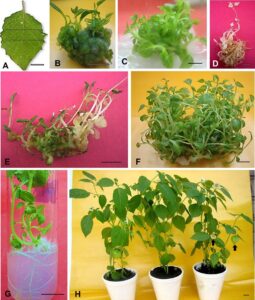Saving the endangered flora of Physalis minima by plant tissue culture
Physalis minima is a promising medicinal plant of the family Solanaceae, but its survival is under
threat, and limited long-term conservation approaches are available. We employed an in vitro plant tissue
culture technique to develop a mass propagation system for the effective multiplication and conservation of P.
minima. Juvenile leaves were cultured on MS basal medium supplemented with 0.1, 0.5, 1.0, 2.0, and 5.0 µM
thidiazuron (TDZ). As a result, 100% callus induction was achieved on the medium containing 1.0 µM TDZ.
Notably, calli grown on 1.0 µM TDZ exhibited greater potential for shoot regeneration and proliferation in
the growth regulator-free MS liquid medium (95.25%) as compared to the solid medium (89.00%). Shoot
cultures remained viable for up to 15 days without refreshing the medium and could be sustained for 12
months when sub-cultured every 15 days. Invigoration of albino shoots with fresh MS basal medium resulted
in multiple green buds, which successfully transformed into 54.60 and 652.78 healthy shoots in 30 and 120
days, respectively. These shoots were rooted, acclimatized, and transferred in field conditions. The present
study thus establishes a simple in vitro liquid culture system for the mass propagation of P. minima, providing
a strategy for the long-term conservation of multiple endangered plant species.


